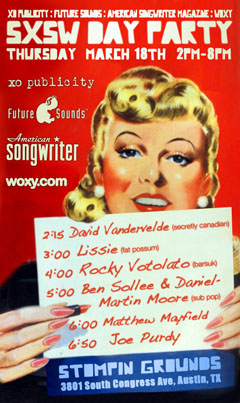Videos by American Songwriter
A classically-trained cellist, an in-demand Americana accompanist, a soulful singing solo artist, a ballet score composer, and a bike-riding environmentalist – these are accurate ways to describe the multi-talented Ben Sollee. The Kentucky native’s young career has been notable for its artistic diversity and creative productivity. This year alone he has put out a live album (Live at the Grocery on Home), had two ballet scores produced (Dangerous Liaisons and Sansei), biked to his show at the Newport Folk Festival, and now his latest studio album, Half-Made Man is set for release on September 25th. Half-Made Man, which he financed with fan funding, reveals his ever-evolving musical sound, combining elements from folk, pop, soul, and classical styles and making them his own. The album also features contributions from Abigail Washburn, My Morning Jackets’ guitarist Carl Broemel, and Turtle Island Quartet fiddler Jeremy Kittel. Sollee talked recently about his new album, his musical inspirations and his dream of being a dancer.
With your new album Half-Made Man, did you go in with a specific strategy on what type of album you wanted to create? And, if so, how did the end result compare with your original intention?
Half-Made Man is an album of self-portraits. Some of the performances are more “posed” than others, but for the most part the record was always about capturing a raw, uncurated expression of the various parts of me. To do so, I invited these four amazing musicians to record live in the studio. Over the two weeks we were together we focused on capturing performances that had a certain energy; we called it “the star-chamber.” And, that’s “star” with the celestial interpretation.
The recording seemed to be a rather quick one. Were you open to contributions from the guest performers? Can you talk a little about this album’s recording process?
In contrast to my previous records, where I spent a tremendous amount of time composing and over-dubbing parts, this record was a collaborative endeavor. Working from skeletal demo recordings we collectively arranged and orchestrated the songs in an organic way. When listening to the final record I can hear each musician’s distinct voice, which satisfies me. It’s a testament to these players’ musicianship that a jazz/hip-hop bassist, Scottish fiddling champion, rock guitar hero and all-in-one drummer can come together and make such a unique sound.
Do you see your albums as part of a musical evolution or just distinct projects? I have seen these songs described as being your most personal to date.
My songs come from a personal place and as I evolve and grow, so does the music. That being said, each recording is an opportunity to tell a different piece of my story. So, I let each album live in it’s own space. They are distinct but they come from the same well-water.
Your music incorporates a wide range of styles (from classical to soul, country and beyond), do you draw upon music from throughout your life that connects with you?
Of course. However, I also draw a lot of inspiration from other disciplines in the arts. I LOVE dance! Movement really inspires my music. Visual art always gets me thinking and is certainly as important as ever to incorporate in this digital, always-on age. I also am kind of a design and architecture geek. It is endlessly fascinating to me how we humans relate to the natural world with our fancy machines and our built spaces.
You also have been involved in a variety of projects. Recently you did a couple ballet scores. How did you get involved in those?
My dream is to be a dancer. For a few reasons, that hasn’t worked out (probably for the best). As an art form, dance communicates ideas and expressions more clearly than any other discipline. Unfortunately, that often results in an audience that struggles to understand depth of craftsmanship in performance.
The two ballets that premiered this year were a result of collaborations over the years. The performance with the Louisville Ballet was a work entitled Sansei, choreographed and staged by Mikelle Bruzina. It was a narrative ballet focused on a Japanese-American family, their traditions, and the transition between matriarchs. The music mixed traditional Japanese melodies with the rolling, circular rhythms of old-time fiddling. The second ballet, which also premiered in April, was a contemporary, super-erotic telling of Dangerous Liasonswith the North Carolina Dance Theater and choreographer Sascha Janes. It was an epic 55 minutes of solo cello with electronics, swinging from a floating platform above, around, and (nearly) on the stage. It was a trip! I hope we can perform it again sometime.
Do these outside projects wind up influencing your own music? Do you plan to continue exploring different creative and musical avenues?
I don’t really think of them as outside projects. My music is about collaboration and inclusion. Doing these ballets and working on film scores helps me grow and develop my musical language, but they are equal parts of my story.
You seem to enjoy collaborations. Do you have dream projects that you’d like to do in the future (either with others or on own)?
I’d love to do a project with Bill Cosby. I’m a huge fan and I think that man is brilliant. I’d also love to work with Brad Mehldau and Ani DiFranco. For the most part, collaborations reveal themselves to me rather than me making direct connections… so we’ll just see what happens!
You frequently tour by bike. You did one up the East Coast this summer. What are the challenges of a bike tour and what are the rewards?
Naturally, there are some physical challenges on bike tours, especially since we choose to haul our gear by bike as well. One can only ride so far, so fast. However, that is the reward as well. There’s no one asking you to drive through the night or fly across the country twice in a weekend. You’re on a bike! The limitation is its own kind of freedom. I find myself to be happier and healthier on bike tours as well as more engaged with the communities that I’m traveling through.
You used pledgemusic.com to help finance your new album. Do you see this as a significant new music business model and a way to connect more with fans? Does it also fit into your DYI approach (like the bike tour)?
I see it as a powerful business model that has been amplified by today’s technology. But it’s important to recognize that fan support and funding has always been the backbone of the music industry. So, it is not significant because it is new, but rather because it gives the artists and fans direct access to each other. It’s a young relationship and, just like high school, there can be awkward moments. But, it will mature and grow in to something beautiful. I’m especially grateful to my fans for their support. Holy crap! I mean, they really came through on Half-Made Man.
The cello isn’t a typical lead instrument in non-classical music. Have you ever had second thoughts about sticking with the cello over the years as a singer-songwriter? Are there advantages you find with making music with the cello? (obviously biking with a guitar would be easier). And do you still find people head-scratching that you are a cellist and solo (for lack of a better word) Americana performer?
What an eloquent way to ask this question…There is no path through the woods of the music industry for a pop-oriented, singing cellist. That being said, much like the bicycle, it allows a considerable amount of freedom and collaborative opportunities; two things I find essential to my musical health. The cello itself, considered as simply a tool, is a wonderful instrument for a songwriter to take up. It’s like a Swiss army knife. It can provide intense rhythm, subdued drones, an incredible melodic range and amazing harmonic textures. If you’re going to grab one instrument to take on the road and not have to deal with a bunch of electronics, the cello is the best one-stop shop.











Leave a Reply
Only members can comment. Become a member. Already a member? Log in.